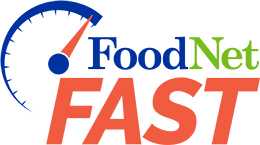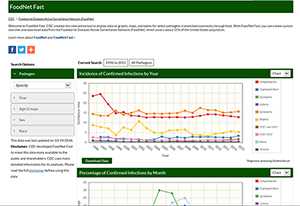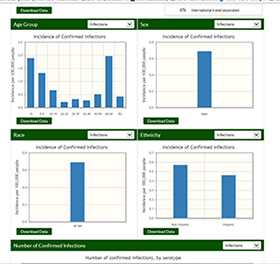FoodNet Fast

FoodNet Fast is CDC’s interactive online program for getting information on cases of illness reported to the Foodborne Diseases Active Surveillance Network (FoodNet). FoodNet Fast makes it easy for users to see how rates of illness have changed over the past 20 years for nine pathogens transmitted commonly through food: Campylobacter, Cryptosporidium, Cyclospora, Listeria, Salmonella, Shiga toxin-producing Escherichia coli (STEC), Shigella, Vibrio, and Yersinia.
Start exploring FoodNet Fast now — or read on for more information to help get you started: Background Information, Using FoodNet Fast, Tips and Tricks.
Why did CDC develop FoodNet Fast?
People and organizations—public health workers, consumer advocacy groups, the medical community, the food industry, and the public—often have questions about foodborne illness burden and trends. CDC created FoodNet Fast to share FoodNet data so people can quickly and easily learn how many cases occurred in certain areas or over certain time periods, which groups were affected, and how the number of cases changed over time.
What kind of data are available from FoodNet Fast?
FoodNet Fast has information on cases of infection reported to FoodNet from 1996 through 2016. Data for 2016 is preliminary. The program lets you search by pathogen, year, age group, sex, and race. FoodNet Fast also provides information on ethnicity, seasonality, hospitalizations, deaths, travel-associated cases, and outbreak-associated cases. You can see species or serotype information when viewing a single pathogen (for Campylobacter, species data are available starting in 2010). Click here to see Tips and Tricks for using FoodNet Fast.
For bacterial infections, FoodNet Fast includes information on confirmed cases and, from 2012 forward, cases diagnosed with a culture-independent diagnostic test (CIDT), or CIDT-positive cases. FoodNet Fast also includes confirmed cases of parasitic infections.
Where do FoodNet Fast data come from?
Data in FoodNet Fast come from the Foodborne Diseases Active Surveillance Network (FoodNet).
Public health officials regularly obtain reports from clinical laboratories in Connecticut, Georgia, Maryland, Minnesota, New Mexico, Oregon, Tennessee, and selected counties in California, Colorado, and New York about infections diagnosed in residents of these areas. FoodNet personnel at each site investigate these reports, collect specific information, and send that information to CDC. Learn more about the FoodNet surveillance sites >
What is a CIDT-positive case and how is it different from a confirmed case? Which CIDT-positive cases does FoodNet Fast describe?
A CIDT-positive case is a positive result from a culture-independent diagnostic test (CIDT) that was not confirmed by culture, either because culture was not performed at the clinical or public health laboratory or because a culture did not yield the pathogen. A CIDT is positive when antigen or nucleic acid sequences of the bacterial pathogen are detected in a stool specimen or enrichment broth. A CIDT is positive for STEC when Shiga toxin or the genes that encode a Shiga toxin are detected in a stool specimen or enrichment broth.
For bacterial infections (Campylobacter, Salmonella, Shigella, Shiga toxin-producing Escherichia coli, Listeria, Vibrio, and Yersinia), a case is confirmed if the bacterium was isolated (through culture) from a patient’s specimen. For parasitic infections (Cryptosporidium and Cyclospora), a case is confirmed if a parasite was detected by direct fluorescent antibody test, polymerase chain reaction, enzyme immunoassay, or light microscopy.
FoodNet Fast only describes CIDT-positive cases for bacterial infections. Although tests used to diagnose Cryptosporidium and Cyclospora infections do not result in a culture, all of these cases are considered confirmed.
Does FoodNet Fast give a complete picture of all foodborne cases in the United States?
No. FoodNet Fast includes information on cases among people who reside in FoodNet’s surveillance area. FoodNet does not receive information on cases of illness among people who do not have a positive laboratory test, such as patients associated with an outbreak who do not submit a specimen for testing.
In addition, not all cases of illness are identified. Many ill people do not seek medical care. For those who do, a specimen may not be obtained or it may not be tested for the pathogen that caused the illness.
Where can I find CDC summaries or reports using these data?
Preliminary data from the previous year are published in the Morbidity and Mortality Weekly Report (MMWR) each spring. Final data are summarized in the FoodNet Annual Report, which is released later, after updated census information becomes available. Read the FoodNet annual reports >
Why are data on the current year not yet available?
It takes time for public health authorities to complete their case investigations and then to report the results to CDC. CDC reviews the reports for missing information in key data fields and works with state and local health departments to correct errors. CDC updates FoodNet Fast after finalizing the reported information.
Using FoodNet Fast
What is an incidence rate? How do you calculate it?
Incidence refers to the occurrence of new cases of disease in a population over a specified period of time. Incidence rates in FoodNet Fast are calculated by dividing the number of cases by the number of people in the population under surveillance and multiplying by 100,000. Standardizing the rate by multiplying by 100,000 allows direct comparisons among categories. The rate is the number of illnesses per 100,000 people. For example, a rate of 15.9 per 100,000 for Salmonella infection means that there are 15.9 cases of Salmonella infection for every 100,000 people in the population under surveillance.
What do you mean by a "travel-associated” case?
This is a case of illness in a person who traveled outside of the United States (international travel) in a specified time period before the illness was diagnosed, meaning the infection likely was acquired abroad. Travel is assessed within 30 days before illness began for Listeria, Salmonella Typhi, and Salmonella Paratyphi A, B, C infections; within 15 days before illness began for Cryptosporidium and Cyclospora infections; and within 7 days before illness began for Campylobacter, Salmonella serotypes other than Typhi and Paratyphi A, B, and C, Shigella, Vibrio, and Yersinia infections.
What do you mean by an “outbreak-associated” case?
This is a case of illness linked to an outbreak, as defined by the occurrence of two or more cases of a similar illness resulting from a common exposure.
Can I search by specific states?
Yes. FoodNet Fast provides incidence rates by state, year, and pathogen.
How did changes in surveillance affect data available in FoodNet Fast?
Because of changes in the surveillance area, most markedly in 2004 when the catchment area grew from 5% to 15% of the U.S. population, incidence from early years cannot be compared to incidence from later years. In addition, not all variables were collected in all years. For example, collection of data on international travel and outbreak association began in 2004. For Campylobacter, species information is available from 2010 and forward on a sample of isolates that have species information. For Salmonella, improved recognition of some serotypes and changes in reporting practice may explain increases in cases such as for Salmonella serotype I 4,[5],12:i:-. Information on CIDT-positive cases has been collected only since 2012.
Can I obtain more information than is included in FoodNet Fast?
Yes. Data in FoodNet Fast are a subset of data collected by the FoodNet sites. Contact foodnet@cdc.gov to submit a request for additional data.
What is the proper citation to reference FoodNet Fast?
Centers for Disease Control and Prevention (CDC). FoodNet Fast. Atlanta, Georgia: U.S. Department of Health and Human Services. Available from URL: http://wwwn.cdc.gov/foodnetfast. Accessed MM/DD/YYYY.
Tip and Tricks
How can I customize my search?
The default view for FoodNet Fast shows data for confirmed cases of all pathogens from 1996 through the most current year of finalized data. You can customize your search using the following options (located to the left of the charts in FoodNet Fast):
-
Pathogen:
-
Single pathogen: If you choose a single pathogen, you can choose to see only confirmed cases (default setting) or confirmed and CIDT-positive cases. You can also choose to display associated subgroups. Examples of queries you can run include:
- Confirmed cases of Salmonella
- Specific Salmonella serotypes, e.g., Montevideo and Muenchen
- Confirmed and CIDT-positive cases of Yersinia
- Multiple pathogens: If you choose multiple pathogens, you will only see confirmed cases. Filters for “confirmed or CIDT-positive” and subgroups will not be displayed.
-
Single pathogen: If you choose a single pathogen, you can choose to see only confirmed cases (default setting) or confirmed and CIDT-positive cases. You can also choose to display associated subgroups. Examples of queries you can run include:
- Year: You can specify a date range
- Age Group: You can specify one or more age groups
- Sex: You can specify male, female, or both
- Race: You can specify one or more races
If you do not select anything in the filter, all confirmed case data for that category will be included.
What’s the difference between dashboard and tabular views?
Dashboard view displays information in a custom array of interactive graphs and charts. Tabular view displays information in a table. Both views show the search box, Quick Stats, and links to download data.
Which graphs and charts are displayed when I select a single pathogen in the dashboard view?
When you select a single pathogen, you will see:
- A line graph showing incidence of infections by year
- A line graph showing percentage of infections by month
- A pie chart showing the percentage of infections by subgroup (species or subtype)
- Four separate bar charts for age group, sex, race, and ethnicity showing incidence of infections
- A bar graph showing incidence of infection by state
If you select a filter for CIDT-positive cases, you will see two lines in the incidence by year and incidence by month graphs (one line for confirmed cases and one for confirmed or CIDT-positive cases), an additional “CIDT” slice in the pie chart, and stacked “CIDT” bars in the bar charts.
A drop-down menu on the upper right of each item allows you to switch between the graph and tabular view. The tabular view provides the data used to create each graph.
The demographic charts (age group, sex, race, and ethnicity) also have the following menu options:
- Infections: Shows incidence rate for all infections of the pathogen selected
- Hospitalizations: Shows incidence rate of hospitalizations
- Deaths: Shows incidence rate of deaths
- Outbreak-associated: Shows incidence rate of outbreak-associated infections
- Travel-associated: Shows incidence rate of international travel-associated infections
Which graphs and charts are displayed when I select multiple pathogens in the dashboard view?
When you select more than one pathogen, you will see:
- A line graph showing incidence of infection by year
- A line graph showing percentage of infections by month
- A bar graph showing number of infections by pathogen
A drop-down menu on the upper right side of each item allows you to switch between the graph and tabular view. The tabular view provides the data used to create each graph.
The CIDT-positive case filter is not available when selecting multiple pathogens.
How do I remove or re-add a pathogen from a graph or chart?
To remove a pathogen from all graphs and charts, uncheck the box next to its name in the search box.
To remove a pathogen from an individual graph or chart, click on its name in the legend. The pathogen name in the legend will then have a line drawn through it indicating you have removed it. To add the pathogen back to the graph or chart, click on its name again. It will appear on the graph or chart and the line through its name in the legend will disappear.
What is “Quick Stats” and how is it useful?
“Quick Stats” provides the number of cases of illness, average incidence rate, and percentage of cases that resulted in hospitalization or death, or were associated with an outbreak or international travel. “Quick Stats” is available when you select a subgroup within a single pathogen or when you add the CIDT-positive case filter to a single pathogen.
When selecting a subspecies within a single pathogen, “Quick Stats: Overall” displays statistics for all cases of illnesses caused by that pathogen. “Quick Stats: Current Search” displays statistics based on the subspecies that you selected. For example, if you create a search for Salmonella Enteritidis, “Quick Stats: Current Search” will display statistics for Salmonella Enteritidis and “Quick Stats: Overall” will display statistics for all cases of Salmonella.
When adding the CIDT-positive case filter to your pathogen selection, “Quick Stats: Confirmed or CIDT-positive” will display statistics for all confirmed or CIDT-positive cases of the selected pathogen, and “Quick Stats: Confirmed” will display statistics for only confirmed cases of that pathogen.
- Page last reviewed: November 7, 2016
- Page last updated: April 20, 2017
- Content source:


 ShareCompartir
ShareCompartir

